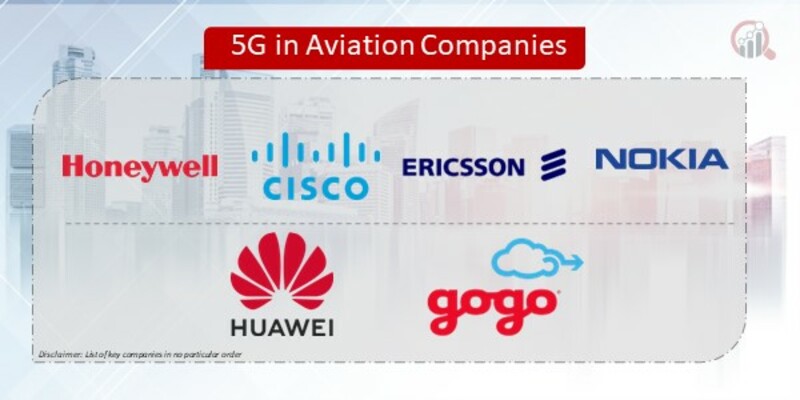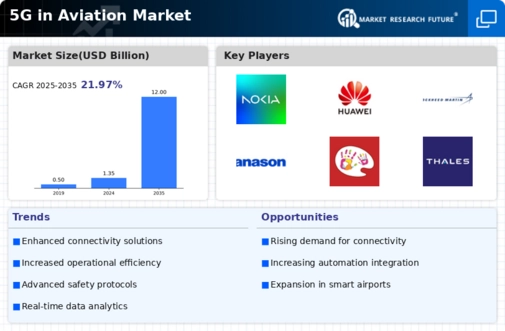Top Industry Leaders in the 5G Aviation Market

Strategies Adopted:
Collaborative Partnerships: Key players in the 5G aviation market collaborate with telecommunications providers, technology companies, regulatory agencies, and industry stakeholders to develop and deploy 5G-enabled solutions tailored to aviation requirements.
Technology Integration: Companies focus on integrating 5G connectivity into existing aircraft systems, including cockpit avionics, passenger Wi-Fi networks, inflight entertainment systems, and maintenance diagnostics, to enhance operational efficiency and passenger experience.
Regulatory Compliance: Compliance with aviation regulations and standards, including safety, security, and data privacy requirements, is critical for the adoption and deployment of 5G technology in aviation, shaping companies' strategies and investment priorities.
Market Positioning: Companies differentiate themselves by offering comprehensive 5G solutions, including hardware, software, services, and support, tailored to the diverse needs of airlines, aircraft manufacturers, and aviation service providers.
Key Companies in the 5G in aviation market include
Honeywell International, Inc. (US)
Huawei Technologies Co., Ltd (China)
Ericsson (Sweden)
Nokia (Finland)
Cisco Systems, Inc. (US)
Panasonic Avionics Corporation (US)
GOGO LLC (US)
Global Eagle (US)
OneWeb (UK)
SmartSky Networks, LLC (US)
Sprint Corporation (US)
SK Telecom Co., Ltd (South Korea)
KT Corporation (South Korea)
Factors for Market Share Analysis:
Product Portfolio and Capabilities: Market share analysis considers the breadth and depth of companies' 5G-enabled product portfolios, including connectivity solutions, applications, and services, as well as their capabilities in technology development, integration, and support.
Customer Relationships: Strong relationships with airlines, aircraft operators, leasing companies, and other aviation stakeholders influence market share, with companies leveraging their industry expertise, reputation, and customer trust to win business and drive adoption of 5G solutions.
Innovation and Differentiation: Innovation in 5G technology, applications, and use cases, as well as differentiation through unique features, performance metrics, and value-added services, contribute to companies' competitive positioning and market share growth.
New and Emerging Companies:
Gogo Inc.: Gogo is a leading provider of inflight connectivity solutions, exploring the integration of 5G technology into its network infrastructure and onboard systems to deliver faster speeds, lower latency, and enhanced services for passengers and crew.
Panasonic Avionics Corporation: Panasonic Avionics specializes in inflight entertainment and connectivity solutions, investing in 5G technology to upgrade its global satellite network and deliver high-speed broadband connectivity to aircraft worldwide.
Industry News and Current Company Investment Trends:
Inflight Connectivity Upgrades: Airlines and aviation service providers are investing in upgrading their inflight connectivity systems to support 5G technology, enabling faster internet speeds, improved streaming quality, and enhanced passenger experiences.
Remote Operations and Maintenance: Companies are exploring the use of 5G technology for remote monitoring, diagnostics, and maintenance of aircraft systems, enabling real-time data exchange, predictive analytics, and proactive maintenance actions to optimize fleet operations and reduce downtime.
Autonomous Flight and Air Traffic Management: The integration of 5G technology into aircraft systems and air traffic management infrastructure is paving the way for advanced applications such as autonomous flight operations, dynamic airspace management, and unmanned aerial vehicle (UAV) integration, shaping the future of aviation.
Overall Competitive Scenario:
The 5G in aviation market is characterized by intense competition among key players, driven by technological innovation, market demand, regulatory requirements, and industry dynamics. Companies differentiate themselves through their 5G-enabled product portfolios, technology integration capabilities, market positioning, and customer relationships. New entrants and emerging companies aim to disrupt the market with innovative solutions, partnerships, and business models tailored to the evolving needs of the aviation industry. Collaboration with industry stakeholders, investment in research and development, and proactive engagement with regulatory agencies are essential for companies to navigate challenges, seize opportunities, and maintain competitiveness in the dynamic 5G aviation market.
5G in Aviation Industry Developments
In November 2020,
The new SESAR project, funded by a European government-industry coalition, will test new wireless network technologies for commercial aircraft controllers to pilot data link communications using Nokia's 4G and 5G wireless network infrastructure (CPDLC).
In September 2020,
Verizon submitted a bid of $1.89 billion for the FCC's auction of 3.5 GHz PALs (Federal Communications Commission).
In November 2020,
The new SESAR project, funded by a European government-industry coalition, tested new wireless network technologies for commercial aircraft controllers to pilot data link communications using Nokia's 4G and 5G wireless network infrastructure (CPDLC).


